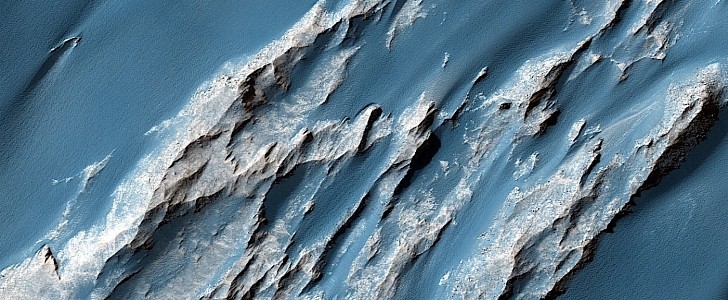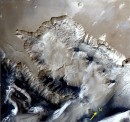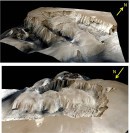We like to fool ourselves that we know quite a bit about our neighboring planet, the one with the most chances in the entire solar system of becoming a second home for us humans. But the planet still holds numerous secrets, some of them being uncovered by hardware on the surface, others by tools we humans put in orbit around Mars.
The things we really don’t know are centered around the presence of liquid water, now or in the past, and the existence of life on the planet. We know there is water in the form of ice, and we think there was a time when some kind of life existed there. And all the observations we’re making keep fueling that knowledge.
The image you’re looking at now was taken by the HiRISE camera in orbit around Mars back in 2008, and brought back into focus not long ago by NASA and the University of Arizona. It shows a region of the planet called Ophir Chasma, where huge landslides usually occur.
In fact, the image shows exactly such a landslide, one that allegedly took place some 3 billion years ago, at about the same time the planet would have had liquid water. The two distinct surface albedos point to different mineralogy and surface evolution.
To the north of the image we get a light-toned view, which according to NASA is the telltale sign of an abundance of hydrated sulfate minerals and bright surface dust. The former is born in the presence of partially acidic liquid water. To the south, the image shows darker tones, which stands for strings of sand drifts.
“Additionally, the underlying units of bedrock consist of darker minerals with less hydration then those to the north, implying a change in the ancient aqueous environments that formed them,” say the scientists.
Those are not things we didn't already know about the planet, but seeing such features from up high can help scientists better understand the planet before we actually reach it. As for Ophir Chasma, that’s a 300 km-long (186 miles) canyon, and it is part of the largest canyon system in the solar system, Valles Marineris.
The image you’re looking at now was taken by the HiRISE camera in orbit around Mars back in 2008, and brought back into focus not long ago by NASA and the University of Arizona. It shows a region of the planet called Ophir Chasma, where huge landslides usually occur.
In fact, the image shows exactly such a landslide, one that allegedly took place some 3 billion years ago, at about the same time the planet would have had liquid water. The two distinct surface albedos point to different mineralogy and surface evolution.
To the north of the image we get a light-toned view, which according to NASA is the telltale sign of an abundance of hydrated sulfate minerals and bright surface dust. The former is born in the presence of partially acidic liquid water. To the south, the image shows darker tones, which stands for strings of sand drifts.
“Additionally, the underlying units of bedrock consist of darker minerals with less hydration then those to the north, implying a change in the ancient aqueous environments that formed them,” say the scientists.
Those are not things we didn't already know about the planet, but seeing such features from up high can help scientists better understand the planet before we actually reach it. As for Ophir Chasma, that’s a 300 km-long (186 miles) canyon, and it is part of the largest canyon system in the solar system, Valles Marineris.






